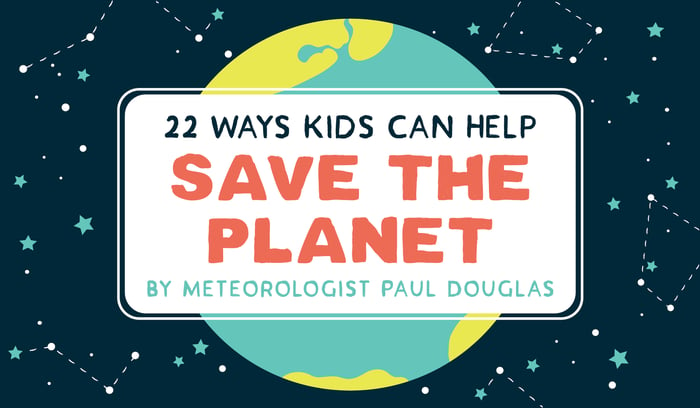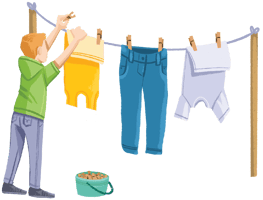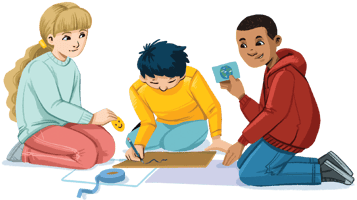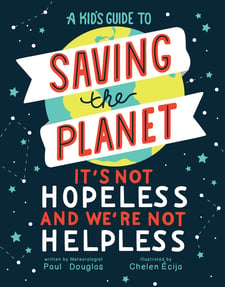The average American family produces 7.5 tons of CO2 every year. Each one of us can think of ways to reduce that number, and then can put those methods into action. We can take steps today to heal the planet. Some are easier than others, and some will have to wait until you are older, when you can purchase an energy-efficient electric vehicle, put solar panels on your home, or choose a green career. But below are a whole lot of great ideas for things you can do today.
Remember, the situation isn’t hopeless, and we aren’t helpless. That’s not just a slogan—it’s the truth. A clean, green revolution in how we power our homes and drive our vehicles and grow our food is well underway.
Plant a tree. Sometimes the simplest ideas are the most powerful. Trees are the perfect carbon-removal devices. They absorb CO2 and release oxygen. A greater number of trees can remove more carbon from the atmosphere faster. Look into public resources like local clubs that provide trees for planting in your area. If you have a yard, plant trees close to home to provide shade and natural cooling during the summer.
Consider planting a vegetable garden. Fresh fruits and vegetables from your local grocery store travel an average of 1,500 miles from the farm to your plate. The more food you grow yourself, or purchase from local sources, the less food must be transported on planes, trains, and trucks. This saves energy, is healthier, and is fun.
Adjust your thermostat to use less air conditioning during the warm months and less heat during the cool months. Even a few degrees can save money and pump fewer climate-warming greenhouse gases into the sky. Instead of cranking up the air conditioning when it’s hot outside, see how long you can go with a fan, which uses a tiny fraction of energy compared to AC. When it turns cold, go old-school by putting on a sweatshirt and socks. Hey, it worked for our ancestors!
Upgrade your home with energy-efficient light bulbs. Talk with your parents or caregivers about swapping old incandescent bulbs for new compact fluorescent lights (CFLs). They use 25% as much electricity to give out the same amount of light, and they last ten times longer! Pro-tip: They will also save money on electric bills!
Unplug electronics when not in use, including video games, coffee makers, and smart speakers. Even when turned off, these vampire gadgets “sip” small amounts of electricity. Plug them into a power strip with an on/off switch, so you can turn off all the power without unplugging every gadget. Turn off lights, TVs, and all other screens and computers when you don’t need them.
Upgrade appliances. Refrigerators, microwaves, dishwashers, clothes washers, dryers, and in-home air-conditioning units manufactured before 2001 are much less energy efficient than more current appliances. New refrigerators beep if the door is left open. Smartphone apps can alert you if the air conditioner is running when you aren’t home. It is all about timing: you can even schedule your dishwasher to run later at night, when electricity is cheaper!
Rethink your laundry. Roughly 75% of total energy use and greenhouse-gas emissions produced by a single load of laundry comes from warming the water. Consider washing in cold water, which is just as effective. Dryers are one of the most energy-hungry appliances. Air-drying your clothes can reduce the average home’s carbon footprint by 2,400 pounds a year.
Keep lights turned off when possible. When you’re reading or doing homework, find a spot that can take full advantage of (free!) natural light. Windows are marvelous inventions. Use them.
Walk or ride a bike. Cars are big producers of CO2. Even a short, two-mile car trip puts two pounds of additional CO2 into the atmosphere. When possible, try walking or biking to replace car trips. Pro tip: It’s a much healthier way to get from point A to point B!
Use smart transportation. For longer travel, consider taking a train or bus instead of driving or flying to your destination. You'll emit far less CO2 getting from Point A to Point B. Something as simple as keeping your car’s tires properly inflated can save significant energy over time too.
Just say no to the drive-thru. When you go to a fast-food restaurant, park the vehicle and walk inside. Sitting in your car, waiting for food, means more idling and more pollution.
Recycle! Take time to separate out aluminum cans, cardboard, plastic, glass, newspapers, and junk mail—anything made of paper. This cuts down on waste sent to incinerators and landfills; conserves timber, water, and minerals; saves energy; and prevents pollution.
Drink tap water in a reusable container. Plastic bottles are a disaster for the planet. Stay hydrated in a smarter way. Here is a dirty little secret: tap water usually tastes just as good as that fancy water you have to pay for.
Buy responsibly. Companies are getting better with using less packaging material to ship products, but this is still a global problem. Think of all the trees that went into all that cardboard required to get that new video game to your house. Shop in-store to cut back on those shipping materials, and choose products with less packaging. Keep a dedicated reusable cloth bag on your bike or in the family car to bring items home from the store, to cut down on the need for paper or plastic bags.
Support companies that acknowledge climate change. Before you buy a product or service, find out if that business is serious about reducing pollution and waste and pushing forward on climate solutions. A simple Google search will answer your questions. More and more companies are stepping up—we should reward the ones that do it right.
Buy less. You are not what you buy. More stuff won’t make you genuinely happy—only faith, family, and friends can do that. Instead of purchasing a new item, ask yourself if you can get by with something gently used. Recycle, reuse, and reimagine what you really need and where you can find it. From vintage clothing to recycled furniture, newer is not necessarily better!
Insulate your home. Making your home more weatherproof can save you big money on heating and cooling expenses throughout the year. That can sometimes mean new windows, but even something as simple as caulking and weather-stripping your home can make a big difference.
Tweak your water heater. Lowering your water temperature from 140°F to 120°F prevents accidental scalding and saves significant energy over time.
Go solar! Clean, green energy is not a fad or a fluke—it is a trend. Why wouldn’t we try to harvest the free energy hitting our yards and rooftops? Prices are falling rapidly, and many families are already taking advantage of solar power, wind energy, and energy storage. Ask your parents to encourage the utility that provides your electricity to take full advantage of renewable energy sources.
Inspire others! Share your concerns and ideas about how to make things better. Write a blog post, design posters to hang at school, or record a TikTok to get the word out and challenge others to do their part.
Share your concerns. Author C. S. Lewis said it best: “Nothing is really ours until we share it.” Share your concerns, fears, and hopes. Talk it out. Speak up. Raise your voice. If you are worried about climate change, do something and say something. Get your friends and family up to speed. You can do this.
Consider a "green career." If you are passionate about combating climate change or other forms of pollution, consider a job that helps to bring about the future you want—faster. Eleanor Roosevelt, wife of Franklin D. Roosevelt, America’s thirty-second president, said, “The future belongs to those who believe in the beauty of their dreams.” Bottom line: Dream big dreams, but take steps to turn those dreams into reality.
Take the first step and make your own path. Your actions will trigger a chain reaction. Others are watching to see what you will do. Once you get started, you will inspire others to take similar actions. Being part of the solution will not only make you feel good—it will make our inevitable clean-energy future one big step closer!
This is an excerpt from A Kid’s Guide to Saving the Planet chapter 6: “Climate Solutions You Can Do.”







